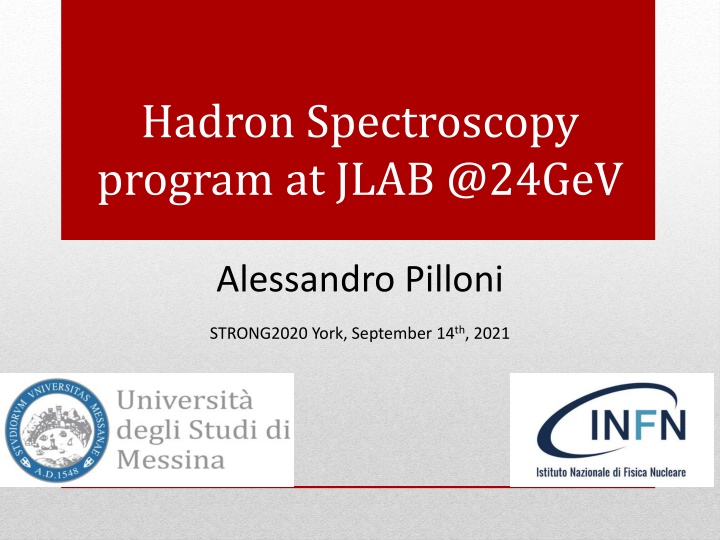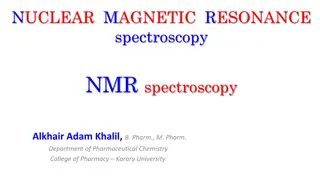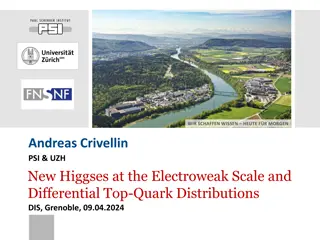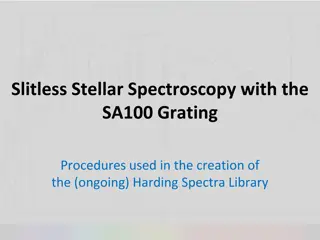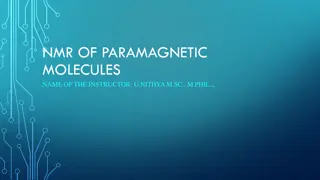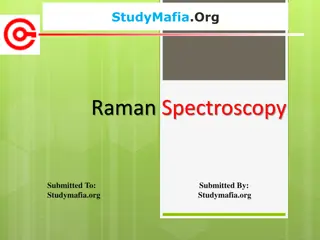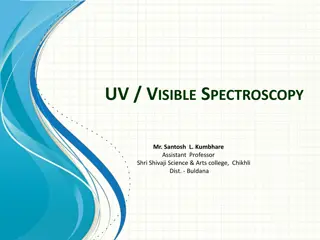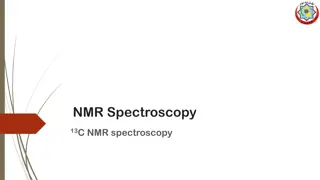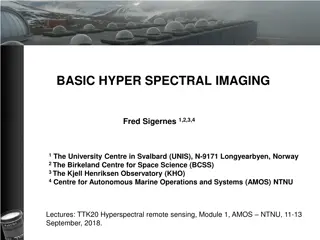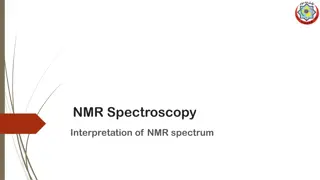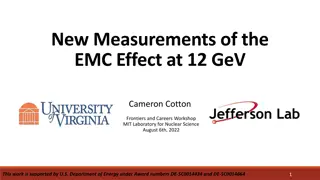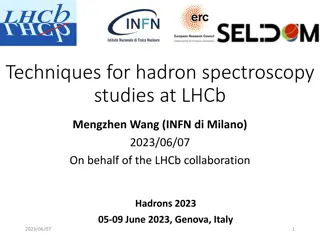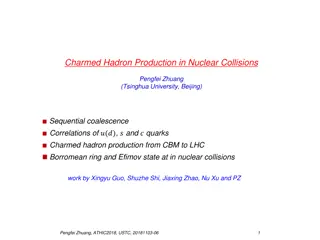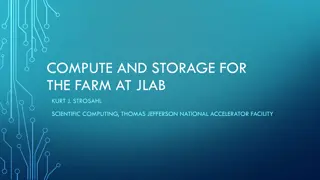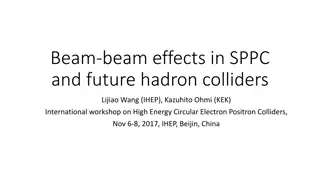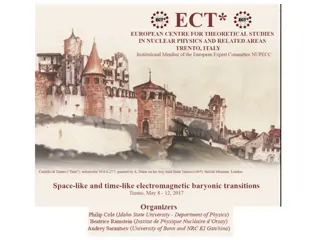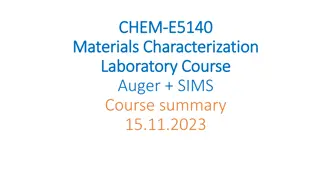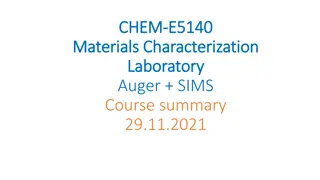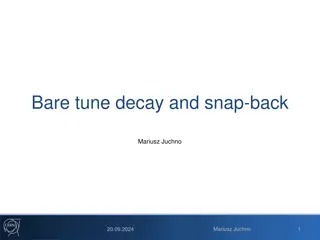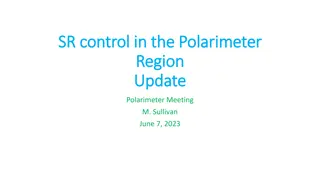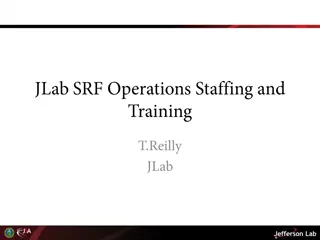Hadron Spectroscopy program at JLAB @24 GeV
Discover the intriguing landscape of hadron spectroscopy at JLAB @ 24 GeV through exotic mesons and quarkonium-like resonances. Explore models of compact multiquark systems and the importance of photoproduction in understanding these phenomena.
Download Presentation

Please find below an Image/Link to download the presentation.
The content on the website is provided AS IS for your information and personal use only. It may not be sold, licensed, or shared on other websites without obtaining consent from the author.If you encounter any issues during the download, it is possible that the publisher has removed the file from their server.
You are allowed to download the files provided on this website for personal or commercial use, subject to the condition that they are used lawfully. All files are the property of their respective owners.
The content on the website is provided AS IS for your information and personal use only. It may not be sold, licensed, or shared on other websites without obtaining consent from the author.
E N D
Presentation Transcript
Hadron Spectroscopy program at JLAB @24GeV Alessandro Pilloni STRONG2020 York, September 14th, 2021
Exotic landscape Estimates in M. Albaladejo et al. [JPAC], 2008.01001 LoI RF7_RF0_120 2 A. Pilloni Hadron Spectroscopy at JLAB @24GeV
?(3872) Discovered in ? ? ? ? ?/? ?? Quantum numbers 1++ Very close to ?? threshold Too narrow for an above- treshold charmonium Isospin violation too big ? ?/?? ? ?/??~0.8 0.3 Mass prediction not compatible with ??1(2?) Sizeable prompt production at hadron colliders, 5% of ?(2?) ? = 3871.68 0.17 MeV ?? ??? = 3 192 keV = 1.19 0.19 MeV ??? ?(? ?/???) = ( 0.11 0.15 nb @CMS 1.06 ) 3 A. Pilloni Hadron Spectroscopy at JLAB @24GeV
Charged ? states: ??3900 ,??(4020) Charged quarkonium-like resonances have been found, 4q needed Two states ???= 1+ appear slightly above ?( )? thresholds ?+? ??3900+? ?/? ?+? and ?? +? ? = 3888.7 3.4 MeV, = 35 7 MeV ?+? ?? 4020+? ? ?+? and ? 0? +? ? = 4023.9 2.4 MeV, = 10 6 MeV 4 A. Pilloni Hadron Spectroscopy at JLAB @24GeV
Models Compact Multiquark Several (cluster) of valence Hybrids Containing gluonic degrees of freedom quarks Hadroquarkonium Heavy core interacting with a light cloud via Van der Waals forces ? ?/? ? ? Rescattering effects Structures generated by cross-channel rescattering, very process-dependent Molecule Bound or virtual state generated by long-range exchange forces Extended 5 A. Pilloni Hadron Spectroscopy at JLAB @24GeV
Exotic landscape Broad mesons seen in ? decay: ?(4140), Z(4430), ???(4000)... Narrow structures seen in ? decay: ? 3872 ,??, (???) Scarce consistency between various production mechanisms Narrow structures seen in ?+? : ?(3872), ?(4260), ??,? ( ) 7 A. Pilloni Hadron Spectroscopy at JLAB @24GeV
Why photoproduction? It s new: no XYZ state has been uncontroversially seen so far It is free from rescattering mechanisms that could mimic resonances in multibody decays The framework is (relatively) clean from a theory point of view Radiative decays offer another way of discerning the nature of the states 8 A. Pilloni Hadron Spectroscopy at JLAB @24GeV
Exclusive (quasi-real) photoproduction XYZ have not been seen in photoproduction so far : independent confirmation Not affected by 3-body dynamics: determination of resonant nature Experiments in the appropriate energy range are promising We study near-threshold (LE) and high energies (HE) Couplings from data as much as possible, not relying on the nature of XYZ M. Albaladejo et al. [JPAC], PRD ??? ?? ?1 ????1 ??;?1 ?? ???? ?1 ?? |?|????>= < ???? ???=??,?? ?, Bottom vertex from standard photoproduction pheno, Top vertex from measured ? ? decay width exponential form factors to further suppress large t VMD is used to couple the incoming photon to a vector quarkonium V 9 A. Pilloni Hadron Spectroscopy at JLAB @24GeV
Threshold vs. high energy Fixed-spin exchanges expected to hold in the low energy region ? channel grows as ??, exceeding unitarity bound, Regge physics kicks in: Reggeized tower of particles with arbitrary spin at HE ?? ??0+? ? Holds at low energy, fixed spin Holds at high energy, resummation of leading ? power If ? IP, ?0< 1, ??/?? decreases with energy Exchange of heavy particles further suppressed 10 A. Pilloni Hadron Spectroscopy at JLAB @24GeV
? photoproduction The ?? are charged charmoniumlike 1+ states close to open flavor thresholds Focus on ??3900+ ?/? ?+, ??10610+,?? The pion is exchanged in the ?-channel 10650+ (??) ?+ 11 A. Pilloni Hadron Spectroscopy at JLAB @24GeV
? photoproduction Focus on the famous 1++ ? 3872 ?/? ?,? Studying also ? 6900 ?/? ?/? (assumed 0++) ? and ? exchanges give main contributions: need to assume the existence of a OZI-suppressed ? 6900 ?/? ? 12 A. Pilloni Hadron Spectroscopy at JLAB @24GeV
Another ?? A. Guskov COMPASS claimed the existence of a state degenerate with the ?(3872), but with ? = 1 Large photoproduction cross section 12 A. Pilloni Hadron Spectroscopy at JLAB @24GeV
? (vector) photoproduction Focus on the 1 ? 4260 ?/? ?+? , check with ? ?/? ?+? Diffractive production, dominated by Pomeron (2-gluon) exchange Good candidates for EIC: diffractive production increases with energy! We have ??-pomeron coupling from our analyses 1606.08912, 1907.09393 How to rescale from ?/? to ? ? How to rescale from ?/? to ?(4260) ? We assume VMD and ?2? ??? = ?2? ??? ?2(?? ??) (Novikov & Shifman) ?2(? ???) ?2(? ???) 0.55 ??=??? ?? ?2(? ???) =6?? (? ???) ? ?2(? ???) ?2(? ???) ?? = ?2(? ???) ?2(? ???) PS(? ???) ? Caveat : ??(? ???) only known times the leptonic width ?? 11 A. Pilloni Hadron Spectroscopy at JLAB @24GeV
? (vector) photoproduction Existing data allow to put a 95% upper limit on the ratio of ? /?(4260) yields Data from H1 hep-ex/971112 Assuming previous formula, one gets: ?? (cfr. hep-ex/0603024, 2002.05641) ?? ? ?/??? = 0.96% ??= 0.84 ?= 930 ?? 13 A. Pilloni Hadron Spectroscopy at JLAB @24GeV
Primakoff X photoproduction Using measurement of (X ?? ) from Belle, one can get predictions for Primakoff Makes use of ion targets, enhancement of cross sections as ?2 15 A. Pilloni Hadron Spectroscopy at JLAB @24GeV
Diffractive semi-inclusive ?? ph. = Im ? ? ? If the target fragments are separated from the beam ones, one can invoke Regge factorization Quark-Regge duality allows to replace the intermediate hadrons with Pomeron , prediction reliable for ?? 1, ? ??? 2 16 A. Pilloni Hadron Spectroscopy at JLAB @24GeV
An example of yield estimate Example with an ideal SuperCEBAF ?lab 20 GeV, photon flux 108 ?/s Typical target, 500 pb 1 /yr Assuming efficiency 1% 17 A. Pilloni Hadron Spectroscopy at JLAB @24GeV
Conclusions Photoproduction is a valuable tool to study exotic states Complementary infomation to other mechanisms Facilities to study photoproduction at low energies are very welcome to pursue this program Thank you! 18 A. Pilloni Hadron Spectroscopy at JLAB @24GeV
Joint Physics Analysis Center Exclusive reactions: 2008.01001 Inclusive reactions: in progress Code available on https://github.com/ dwinney/jpacPhoto Contact : pillaus@jlab.org 20 A. Pilloni Hadron Spectroscopy at JLAB @24GeV
Pentaquarks! LHCb, PRL 115, 072001 LHCb, PRL 117, 082003 Two states seen in ? ?/? ? ? , evidence in ? ?/? ? ? ?1= 4380 8 29 MeV 1= 205 18 86 MeV ?2= 4449.8 1.7 2.5 MeV 2= 39 5 19 MeV Quantum numbers ,5 2 + + + 3 2 3 2 ,5 2 5 2 ,3 2 ??= or or LHCb, PRL 122, 222001 Higher statistics analysis revealed a two- peak structure of the narrow state, plus a new lighter one Quantum numbers still unknown 21 A. Pilloni Hadron Spectroscopy at JLAB @24GeV
Exclusive ?? photoproduction At Jlab12 measurements of direct ?? production are being performed Using VMD, BR ?? ?/? ? 1% 22 A. Pilloni Hadron Spectroscopy at JLAB @24GeV
Polarized ?? photoproduction ??(?) s channel resonances significant at low energies: u channel dominates at high energies Main background from N(*) trajectories Estimated ??coupling upper bound of same order of magnitude as ?( )coupling Reggeization suppresses ??due to larger mass (smaller trajectory intercept) We estimate that the ??trajectories will hardly be visible at the EIC ??searches still possible: ? channel at higher energies! Cao et al., Phys.Rev. D 101, 074010 (2020) E. Paryev, arXiv:2007.01172 [nucl-th] (2020) 23 A. Pilloni Hadron Spectroscopy at JLAB @24GeV
Primakoff X photoproduction Using measurement of (X ?? ) from Belle, one can get predictions for Primakoff Makes use of the ion beam, enhancement of cross sections as ?2 24 A. Pilloni Hadron Spectroscopy at JLAB @24GeV
Semi-inclusive ? production X. Yao For large ?2 one can invoke NRQCD factorization to describe quarkonium(-like) production Perturbative partonic matrix element, calculable Nonperturbative transition matrix element ? ? ? fitted from data 16 A. Pilloni Hadron Spectroscopy at JLAB @24GeV
Semi-inclusive ? production One can assume the same NRQCD factorization for exotics, independent of their internal structure Artoisenet and Braaten, PRD81, 114018 from Tevatron data If one consider the first term only, it leads to X. Yao 17 A. Pilloni Hadron Spectroscopy at JLAB @24GeV
Some quick thoughts about high intensity At current energies, the only heavy exotic accessible are pentaquarks, negative results from JLab pose a conundrum: Rescattering mechanisms proposed so far are not doing a good job in describing all the peaks All models point to direct-channel physics: must see in photoproduction! Need estimates of BR that go beyond VMD Light spectroscopy notoriously requires complicated PWA, high statistics can be a blessing and a curse Looking for rare channels simpler to reconstruct of interest, ex.: radiative decays of (hybrid) mesons? Requires more theory effort 18 A. Pilloni Hadron Spectroscopy at JLAB @24GeV
